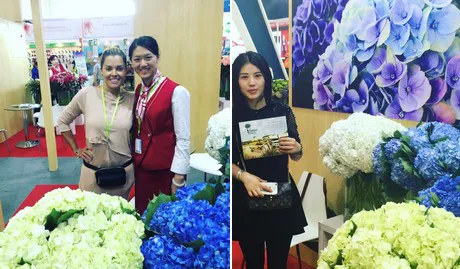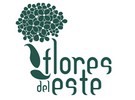The flower industry sees more and more potential in the Chinese market. The growing middle and affluent class of the largest population of the world is willing to pay a premium price for high quality flowers. This is explained by Catalina Arango of Flores Del Este, a Colombian farm that grows hydrangeas. Also they perceive a higher demand from their Chinese customers.
 Catalina Arango, on the left, during her first trip to China; IPM Beijing 2016.
Catalina Arango, on the left, during her first trip to China; IPM Beijing 2016.
Potential for Colombian hydrangeas
“Colombian hydrangeas have a great advantage in this market mainly because Chinese hydrangeas and flowers have a lower quality standard and less quality vase life”, Catalina says. “The only problem is that the Chinese want the best quality hydrangeas at very cheap prices. However, the import of hydrangeas from Colombia increased in 2017 by 21 percent.”
“Chinese people are used to buying traditional flowers like roses, orchids and chrysanthemums, but nowadays they are starting to buy more unique, non-traditional flowers such as hydrangeas. Even though flowers have always been a part of Chinese tradition for weddings, today it is more the symbol they represent that matter the most.”
New generation
The new generations after 80s and 90s generation are the main consumers of fresh flowers in China explains Arango. "Companies are thriving by creating the concept that you can have flowers every day, targeting the new generation of e-commerce consumers. They keep clients active with new designs and ideas."
"Personal consumption of fresh flowers still only accounts for about 10 percent of the total in China," said Dong Wenyi, deputy manager of the Kunming International Flora Auction Trading Center, Asia's largest flower auction center. In comparison: in the Netherlands, more than half of fresh flowers are bought by individuals, and in the United States it is 40 percent. "But it is growing by 10 to 15 percent every year. At the same time, flower plantation areas in China are expanding at an annual rate of 15 percent."
Expanding market
This market is growing comprehensively only since a couple of years ago. "The Yunnan Province, China's largest flower farming region, planted about 87,000 hectares of flowers in 2016. At the Dounan flower market in Kunming, Yunnan's capital, more than 1,000 tonnes of fresh flowers are sent to 80 Chinese cities and 50 countries and regions every day. Last year, Dounan sold over 6.5 billion flowers. Its sales revenue was 5.3 billion yuan", says Arango.
"This demand is being met by a thriving number of online florists, allowing people in big cities to order flowers with a few taps of their smartphone. Internet consulting firm iResearch estimates China’s cut-flower e-commerce market expanded from 1.2 billion yuan (US$188 million) in 2013 to 12.4 billion yuan last year and is likely to close in on 50 billion yuan by 2021."
Fresh flowers instead of fake ones
The revolution in supply has also been reorganized by the flower farming industry. "When flowers were luxuries, farmers only served big holidays such as Valentine's Day and Christmas. That's also why prices of fresh flowers in China are very high", she says. "In 2015 fresh flower purchases in China were mainly limited to festivals and special occasions, often purchased by businesses. Years ago at Chinese homes people chose artificial flowers for the New Year celebrations, but now with imports starting to grow each year more, instead of fake ones, they are buying fresh flowers. The demand of flowers is driven by the development of the urban landscaping, in the need to improve the environment and thereby the quality of life. The demand has also increased a lot from the Chinese citizens that have shown a steady increase.”
For more information
Asocolflores
www.asocolfores.org
Flores Del E ste
ste
Catalina Arango
Email: carango@floresdeleste.com
www.floresdeleste.com
